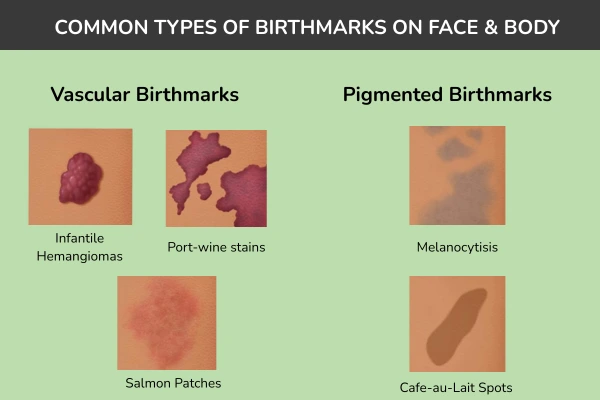Up to 25% OFF on Selected Treatments
-
Treatments
Acne and Scar
Pigmentation
Laser Hair Reduction
Dermato-surgery
Body
Anti Aging
Skin Rejuvenation
Others
- Clinics
- Blogs
Treatments
Do birthmarks on your face make you feel self-conscious, even though they have been with you from birth? Birthmarks can be harmless and even charming, but many people struggle when they appear on prominent locations, especially birthmarks on the face. If you are curious about what birthmarks are, how birthmarks on the face occur, why only a few people have those marks from birth, and how to remove birthmarks effectively due to aesthetic reasons or medical necessity, this blog is for you.
In this comprehensive guide, we will walk you through how to remove birthmarks, understand their causes, and explore expert treatments available at Evenly Clinic in Bangalore. We’ll also uncover the science behind birthmark causes, and answer the most common FAQs so you can make an informed decision.
Birthmarks are congenital skin irregularities that can appear anywhere on the body, including the face. These marks are present at birth or develop shortly thereafter. They arise from an overgrowth of cells, such as blood vessels, pigment cells, or nerve cells. Generally, these marks are harmless, but some birthmarks can pose health risks or become a cosmetic concern. They vary in size, texture, and shape, and their appearance can range from subtle to highly noticeable.
Dermatologists distinguish birthmarks on the face or body into two main types:

These birthmarks stem from the abnormal development of blood vessels beneath the skin, such as capillaries, veins, or lymphatic vessels. They are typically red, pink, or purple in color. Some vascular birthmarks include salmon patches, infantile hemangiomas, and port-wine stains.
These birthmarks result from an excess accumulation of melanin-producing cells (melanocytes) under the skin. They are brown and black in color. Some of the common pigmented birthmarks are congenital moles, cafe au lait spots, and Mongolian spots.
The exact cause of the birthmarks on the face remains unclear, but certain factors influence them:
Let’s have a look at some signs and symptoms of different types of birthmarks on the face:
Most birthmarks on the face are harmless, but if they are large or grow rapidly or are in a prominent location like the face or interfere with normal body functions, Consulting an experienced dermatologist to determine the best treatment plan is essential to manage or remove birthmarks.
As discussed earlier, most birthmarks are harmless, but some types may need medical attention if they:
At Evenly Skin and Hair Clinic, Bangalore we focus on personalized evaluations to assess whether the birthmark on your face requires treatment and to offer the best possible solutions.
Even though the birthmarks are harmless in some cases, some individuals opt for birthmark removal treatment for cosmetic reasons. The optimal treatment to remove birthmark depends on several factors like the type of birthmark, its size, its location, and the patient’s individual concerns. Here are some effective and advanced birthmark treatment options:

Laser treatment is the most effective method for lightening or removing vascular and pigmented birthmarks using advanced Q switched ND YAG laser.
Radiofrequency (RF) ablation is an advanced treatment that uses heat generated by radiofrequency energy to target and treat vascular or pigmented birthmarks.
How It Works:
RF ablation gently destroys the unwanted cells or tissue causing the birthmark, allowing the skin to regenerate naturally.
Benefits:
Corticosteroids are highly effective for treating certain types of vascular birthmarks, such as hemangiomas. They are available in injection form or oral form.
How It Works:
A small dose of corticosteroid is injected directly into the birthmark to reduce inflammation and shrink the abnormal tissue.
Benefits:
Combining expertise and state-of-the-art technology, Evenly Clinic ensures remarkable results every time. Here is what sets us apart:
Birthmarks are part of your story, but if they affect your confidence or health, you deserve removal options. Whether it’s birthmarks on face or anywhere on your body we are here to help you understand on how to remove birthmarks on face safely and effectively without affecting the surrounding area. Book an appointment with Evenly Clinic to get a scar-free birthmark removal.
For health-related information, follow us on Instagram!!
How are birthmarks on the face diagnosed?
Dermatologists typically perform visual examinations and may use imaging techniques or biopsies for a more detailed analysis.
Do birthmarks fade over time?
Certain birthmarks, like salmon patches or hemangiomas, may fade as a child grows, while others, like port wine stains, usually remain.
What causes birthmarks on the face?
Birthmarks arise from irregularities in blood vessel formation, melanin overproduction, or other cellular abnormalities beneath the skin.
What are vascular birthmarks?
These types of birthmarks arise from abnormal blood vessels under the skin and include types like salmon patches, hemangiomas, and port-wine stains.
Can congenital moles become dangerous?
Large or irregular congenital moles may carry a higher risk of developing into melanoma, so they should be monitored closely
How can I tell if a birthmark is dangerous?
Watch for changes in size, color, or texture, or if it starts to bleed, itch, or cause discomfort. It is always best to consult a dermatologist for evaluation.
Can birthmarks grow over time?
Some, like hemangiomas, may initially grow but then shrink later. Others, such as port-wine stains, may become darker or change in texture as a person ages.
We hope this information is helpful. If you have any skin and hair-related questions or would like to discuss personalized solutions, please reach out to us at 7337899030. Our team of specialists is committed to delivering personalized care tailored to your specific needs. Take the first step towards a healthier, more confident you by scheduling a consultation with us today. Your journey to vibrant skin and stronger hair begins here.
Book an Appointment
Start your journey to healthy skin and hair today.
Leave a Comment